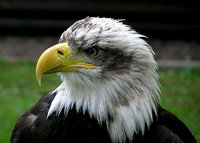 USA Removing Eagle from Endangered Species List
USA Removing Eagle from Endangered Species List
After nearly four decades on the endangered species list, bald eagles are soaring once again, their population climbing from a dismal count of just 417 nesting pairs in the continental United States in 1963 to more than 7,000 today.
With an additional bounty of tens of thousands of the majestic raptors thriving in both Alaska and Canada, the U.S. Fish and Wildlife Service announced in February that it was taking steps to follow President Bill Clinton’s 1999 recommendation to remove bald eagles from protection under the Endangered Species Act.
Despite delisting, two other laws will continue to ban intentional harm to America’s national bird: the 1918 Migratory Bird Treaty Act and the 1940 Bald Eagle Protection Act.
The United States government came to the eagle’s rescue in 1940 with the belief that eagles were in trouble even though the actual population was unknown. Congress passed the Bald Eagle Protection Act making it illegal to kill, harass, possess, or sell bald eagles. “The bald eagle is no longer a mere bird of biological interest but a symbol of the American ideals of freedom,” the law states.
However, the act did not protect the birds from environmental threats, such as the widespread use of DDT and other pesticides after World War II or from lead shot. Eagles ingested large quantities of leftover lead when they ate waterfowl wounded by hunters. Effects in the nest include reduced egg numbers and weakened shells to the point that many would break before chicks could hatch.
In 1973 the bald eagle was one of the first species afforded the full protection of the American government under the new Endangered Species Act. Intentional harm and harassment were banned and habitats protected from further damage and encroachment. In 1972, the Environmental Protection Agency outlawed DDT and in 1991, the use of lead shot in hunting waterfowl, a component of the eagles’ diet, became illegal. An aggressive captive breeding program by USFWS boosted rebounding populations assuring for future generations the prominance of this soaring bird in the American landscape.
related links:




















